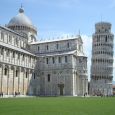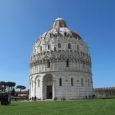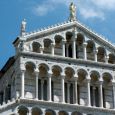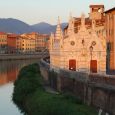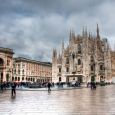Pisa
Advertisement
By Air
Pisa Airport is a substantial, modern facility with adequate amenities for travellers. Flights are offered to and from mostly European destinations, with flights to New York due to commence soon. Several budget airlines offer services to Pisa including Ryanair, easyJet and Transavia among others.
The airport is on the outskirts of the city centre, with the main rail station accessible from the airport in less than five minutes by bus. Bus number 1 operates to and from the airport to Pisa Centrale rail station. Direct shuttle buses also run from outside Arrivals to Santa Maria Novella railway station in Florence, or alternatively you can travel to Florence by rail. Taxis are also available at the airport for travel to the city centre and its hotels.
By Train
Pisa has a substantial rail station, Pisa Centrale, which offers connections to destinations along two major rail lines: the Livorno-Pisa-Florence line and the Thyrrenic line, which runs from Naples to Rome, stopping at Genoa and Turin.
In addition to the city’s main station, the smaller station of Pisa San Rossore is situated closer to the Leaning Tower and connects the city with Lucca and Pistoia.
By Bus
Visitors can reach Pisa by bus, with regular connections to Lucca and coastal destinations as well as to Florence and Rome. Travelling by bus in Italy is the cheapest form of transport; however, unless you are on a tight budget, rail travel is recommended over bus travel.
Campo dei Miracoli
In the northwest of the town of Pisa, enclosed on two sides by the old battlemented town walls, is the Piazza del Duomo or Campo dei Miracoli, with the cathedral, the Leaning Tower, the Baptistery and the Campo Santo - a harmoniously composed group of buildings of unrivaled beauty.
Baptistery
West of the cathedral in Pisa, on the same axis, stands the baptistery - here, as elsewhere in Italy, separate from the church to which it belongs. Construction began in 1153, almost a hundred years after the cathedral but still in the great days of Pisa.
The first architect was one Master Diotisalvi (inscription on pillars flanking the entrance). The likenesses between the baptistery and the cathedral are particularly marked in the earlier phases of the baptistery's construction - the use of the same building material, the patterning with different colors of stone, the articulation of the structure by blind arcading and dwarf galleries.
Since the work of construction continued, with interruptions, for two centuries the architecture of the baptizery shows the transition from Romanesque to Gothic between the lower and the upper levels. In 1260 Nicola Pisano took over responsibility for the project, followed (1285-93) by his son Giovanni. The roof vaulting was completed in 1358, and the 3.30m/11ft high figure of John the Baptist which tops the dome was set up towards the end of the 14th century. Most of the figures on the outside of the building have now been replaced by copies; the originals are in museums.
Cathedral
The Cathedral of Santa Maria Assunta, a five-aisled Romanesque basilica (95m/312ft long, 32m/105ft wide) of white marble with aisled transepts and an elliptical dome over the crossing, was begun in 1063, after the naval victory over the Saracens, to the design of a Pisan architect named Buscheto, and was consecrated, still unfinished, in 1118. Towards the end of the 12th century a new west front was added by the architect Rainaldo and the principal apse was completed.
Leaning Tower
Near the east end of the cathedral in Pisa stands the celebrated Leaning Tower (Torre Pendente), a campanile built between 1173 and 1350, with a series of several superimposed pillared galleries. The tower, which was built on alluvial land, leans to the southeast and is about 5°30' off the vertical; at present the north side of the tower is 56.5m/186.5ft high while the south side measures only 54.25m/179ft.
Santa Maria della Spina
The Church of Santa Maria della Spina, on the left bank of the Arno to the west of the Palazzo Gambacorti, is perhaps the best known of the smaller churches of Pisa. In its original position close to the river it suffered severe damage to its foundations, and in 1871 it was pulled down stone by stone and rebuilt higher up. Originally a small oratory, it was rebuilt in the Gothic period as a richly decorated church. It owes its name to its possession of a thorn (spina) from Christ's crown of thorns, brought to Pisa from the Holy Land.
The west front is surmounted by three gables and has two doorways, with small rose-windows in the gables above. In the center is a baldachin with a statue of the Virgin and Child with Saints by G. di Balduccio. The south side of the church has a series of arches enclosing doorways and multiple windows and, higher up, an aedicule (niche) with figures of Christ and the Apostles. The building is crowned by tabernacles containing statues, some of them now replaced by copies (originals in the Museo Nazionale): for example, the "Virgin and Child" by Nino Pisano and the figures of Apostles by pupils of Giovanni Pisano. The famous "Madonna del Latte" inside the church is also a replica.
Museo delle Sinopie
On the south side of the Piazza del Duomo in Pisa, housed in a former hospice, is the Museo delle Sinópie (opened 1979). During the restoration of the Camposanto a large number of these preliminary sketches for frescoes (sinópie) were discovered, and these are now displayed in the museum. These sketches were the artist's most important contribution to a fresco, specifying as they did every detail of a composition; thereafter the actual execution of the fresco was often left to pupils or assistants. In the museum the sinópie are shown in conjunction with reproductions of the corresponding frescoes.
Information not available


